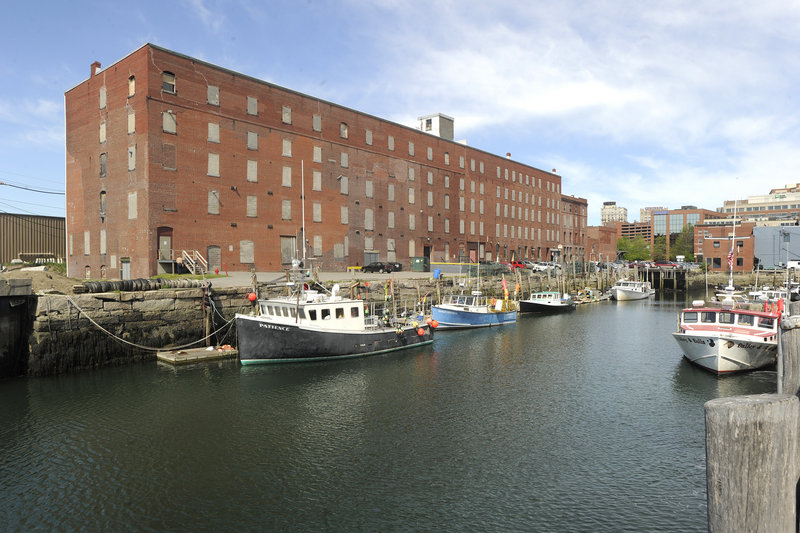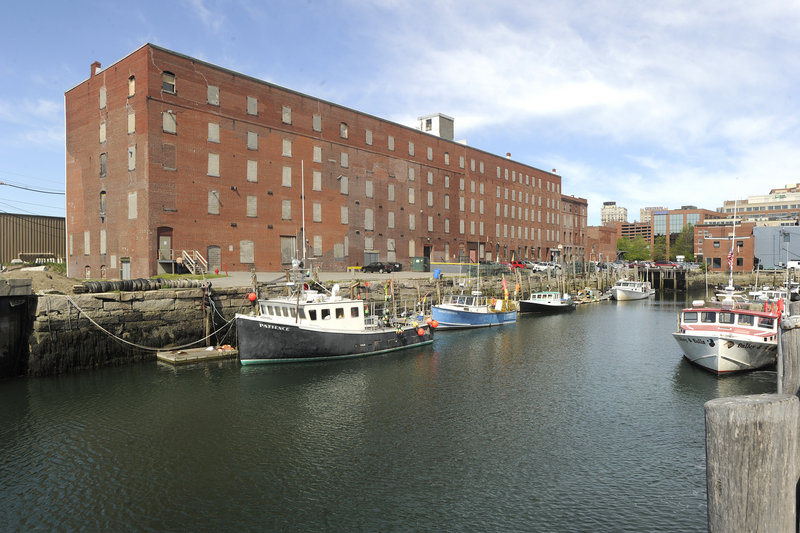PORTLAND – Built a century and a half ago to store rum and molasses, the five-story brick building on Cumberland Wharf is among the largest, oldest and tallest buildings on the city’s waterfront.
It’s an unglamorous structure, a massive, 100,000-square-foot building that has all the grace and style of a shoe box tipped on its side.
“It’s a big, brick box,” said Dennis Keeler, a partner in charge of facilities for Pierce Atwood. The law firm plans to move its headquarters to the building, if it can persuade the City Council to give its renovation project a tax break.
The building’s appeal, Keeler said, is in its spectacular views of the Fore River. But more important, he said, the law firm sees the building’s renovation as an opportunity to connect the 119-year-old firm to the city’s past.
He said the project would lead the revival of that part of the city’s waterfront. “It would be exciting to be part of the history.”
The building’s early history is not well documented. Keeler said he believes the building was the original warehouse for the J.B. Brown Co., preceding the construction of the company’s immense eight-story sugar factory on Commercial Street.
The Great Fire of Portland in 1866 destroyed the factory and 1,500 other buildings, but the original warehouse survived the fire because it was downwind, Keeler said.
1914, the building was owned by Twitchell Champlin Wholesaler Grocers, according to a map of the city produced by the Richards Standard Atlas. The company was started in 1885 by John Q. Twitchell and James P. Champlin.
A. Vinton Lewis, 94, who lives in South Portland and worked on the waterfront for 40 years as a marine contractor, said he remembers that the company used the building to can vegetables, including beans, greens and corn.
In 1962, the waterfront entrepreneur George Lewis bought the building, insulated it with cork and converted it into a cold storage warehouse. He called the business Cumberland Cold Storage. Frozen foods of all kinds were stored there. It was later sold to Robert Levine.
In the 1980s, the building played a central role in Portland’s early battle between proponents of non-marine development and those who wanted to protect the working waterfront.
At one point, a Boston developer proposed converting the building into 146 condominium units. The company dropped its plans after it became clear that the City Council would refuse to rezone the property.
In 1986, after the cold storage facility went out of business, the building was foreclosed on. The Lewis family sold it at auction to Waterfront Maine, which bought the building along with the Fort Andross mill complex in Brunswick.
The company eventually converted the cold storage warehouse into a self-storage facility, changing the name to Cumberland Self Storage.
Waterfront Maine remains the owner of the building today. The managing partner is Coleman Burke of New York City.
In 1988, the Gulf of Maine Aquarium announced that it had a deal with Burke to open a $12 million facility — including a 30,000-square-foot aquarium — in the building. The plan depended on city funding. The plan went nowhere.
James Sterling, an architect in Portland, said it’s great news that Pierce Atwood wants to redevelop the building. It’s a classic warehouse structure, with a clean and “crisp” design, he said.
“It’s good it’s coming back on line,” Sterling said. “To have it sit there and slowly disintegrate it not a good thing. If it takes a law firm to get the ball rolling, that’s fine.”
Staff Writer Tom Bell can be contacted at 791-6369 or at:
tbell@pressherald.com
Send questions/comments to the editors.




Success. Please wait for the page to reload. If the page does not reload within 5 seconds, please refresh the page.
Enter your email and password to access comments.
Hi, to comment on stories you must . This profile is in addition to your subscription and website login.
Already have a commenting profile? .
Invalid username/password.
Please check your email to confirm and complete your registration.
Only subscribers are eligible to post comments. Please subscribe or login first for digital access. Here’s why.
Use the form below to reset your password. When you've submitted your account email, we will send an email with a reset code.